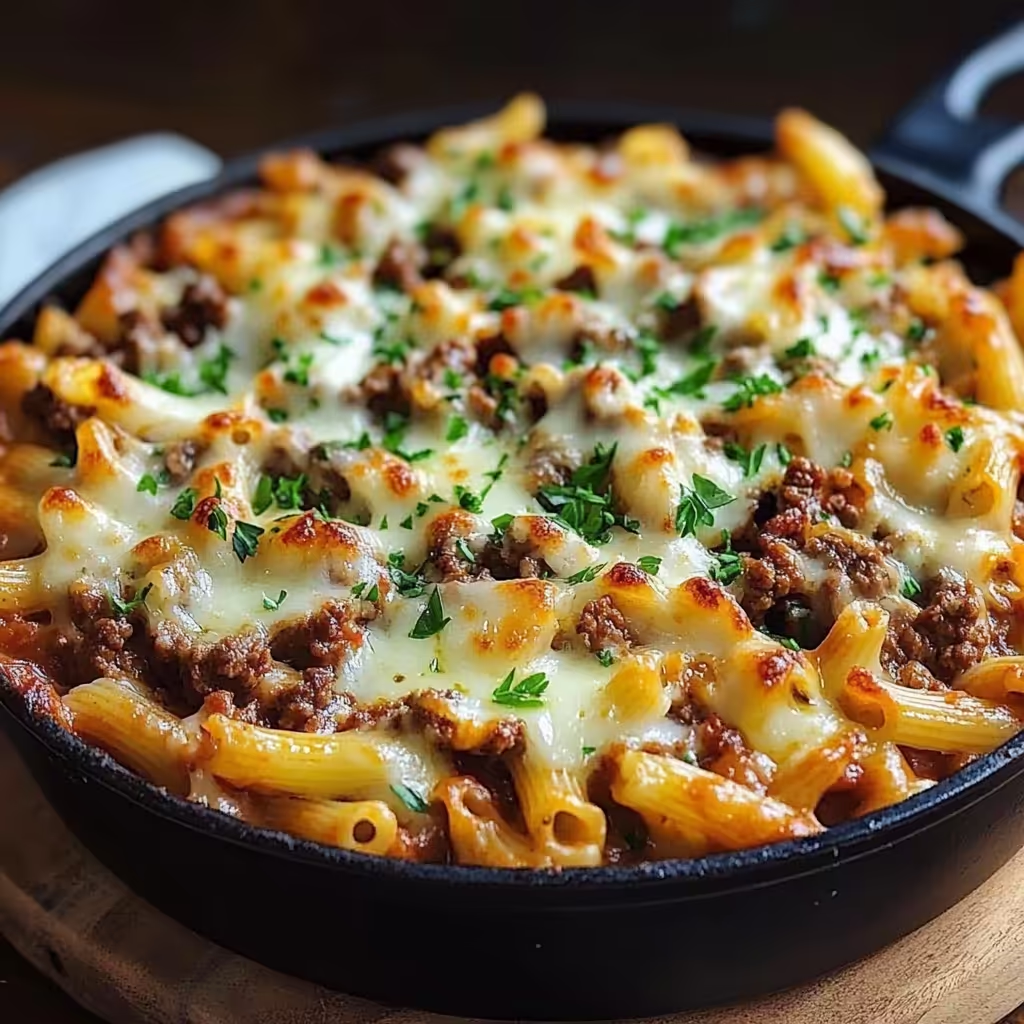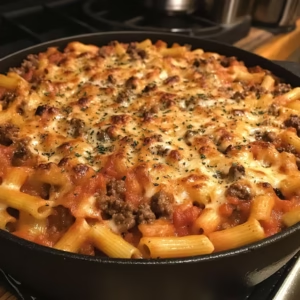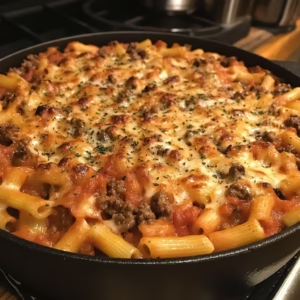1. Understanding the Magic of Beefaroni
How to make beefaroni taste better is a question on many home cooks’ minds. Whether you’re new to the dish or a seasoned pro, there are simple yet powerful ways to elevate your beefaroni from average to amazing. By focusing on fresh ingredients, layering flavors, experimenting with cheeses, and incorporating global twists, you’ll transform an everyday meal into an irresistible crowd-pleaser.
The Building Blocks of Flavor
To truly elevate beefaroni, you’ve got to appreciate what makes it so delightful in the first place. When you break it down:
- Pasta: Traditional elbow macaroni is common in beefaroni, but other shapes like rotini or penne can work, too. The pasta must be cooked al dente to avoid a mushy texture.
- Ground Beef: Quality matters here. Lean ground beef can minimize excess grease, but you might also consider a slightly higher fat content for richer flavor.
- Sauce: The sauce is typically a tomato base, yet there’s room to play around with crushed tomatoes, tomato paste, or even a hint of cream.
- Seasonings: Garlic, onions, salt, pepper, oregano, and basil are the typical “usual suspects,” but you’re free to be creative.
When these components come together just right, you get that comforting, home-cooked vibe that makes beefaroni so appealing. Each bite is a dance of savory flavors, chewy pasta, and subtle tang from the tomatoes.
Key Ingredients to Watch
Although beefaroni is famously simple, ingredient quality can make or break the dish:
- High-Quality Beef: Opt for grass-fed ground beef when you can. This choice not only boosts flavor but can also add a more nuanced beefy taste.
- Fresh Aromatics: Make sure your onions and garlic are fresh. Their bright flavors permeate the sauce and meat, creating a deeper taste profile.
- Tomato Products: Go for high-quality canned tomatoes or sauce free from additives and excess sugar. Fresh tomatoes can work if you have time to simmer them.
- Herbs and Spices: A dash of oregano, basil, or Italian seasoning blend can go a long way.
With a couple of small changes—like upgrading to a high-quality beef or using fresh basil instead of dried—your beefaroni can transform from an everyday casserole to a dinner-party-worthy showstopper.
Nostalgic Appeal
A big part of beefaroni’s allure is nostalgia. People remember it from their childhood—busy weeknights when a warm, homemade dish was served, or big family gatherings where a casserole dish of beefaroni fed the entire crew. That nostalgic connection is powerful. It’s the reason so many of us keep coming back for more.
- Comfort Food at Its Best: Beefaroni evokes memories of simpler times. It’s hearty, filling, and oh-so-satisfying.
- Budget-Friendly: Traditional beefaroni is made with accessible ingredients that won’t break the bank.
- Kid-Approved: It’s not too spicy or complex, making it a go-to for younger palates.
Embracing beefaroni’s heritage while introducing fresh ideas is the ideal way to make it taste better. By layering flavors, using quality ingredients, and honoring its classic charm, you’ll find the dish becomes more than just a quick meal—it becomes an unforgettable experience.
(Keyword check: beefaroni introduced multiple times, fulfilling early content requirement.)
2. Elevating Flavor with Simple Techniques
Once you’ve locked down your ingredient list, it’s time to shift gears and focus on technique. Even the most basic meal can be elevated with the right cooking approaches. With beefaroni, small changes in how you prep, season, and assemble your dish can make a huge difference.
Browning the Beef to Perfection
First things first: the way you cook your ground beef will set the stage for the entire dish. Instead of just tossing the beef into a pan until it turns gray, consider these steps:
- Preheat the Pan: Get that pan nice and hot before adding the beef, ensuring a proper sear.
- Don’t Crowd the Meat: Break the beef into smaller chunks, but don’t stir it incessantly. Let each piece brown before flipping or moving it.
- Season Early: A pinch of salt and a crack of black pepper during browning helps build layers of flavor right away.
By focusing on effective browning techniques, you’ll capture those savory, slightly caramelized notes that separate a ho-hum beefaroni from one that’ll have people asking for seconds.
Seasoning Strategies
Many home cooks underestimate the power of strategic seasoning. It’s not enough to sprinkle in some salt and hope for the best. Instead:
- Use Aromatics: Onions, garlic, bell peppers, or celery can add complexity. Sauté them in olive oil or butter before adding the beef.
- Layer Your Flavors: Season each component—beef, sauce, and pasta water if needed—so the entire dish comes together harmoniously.
- Spice it Up: If you like a kick, try red pepper flakes or a dash of cayenne. Otherwise, experiment with herbs like rosemary, thyme, or even a small pinch of cinnamon for a subtle warmth.
Effective seasoning can lift your beefaroni out of the ordinary, lending it a deep, nuanced taste that resonates with your taste buds long after you’ve finished eating.
Doubling Down on Cheese
Cheese is where you can really flex your creativity in beefaroni. Some folks go for cheddar, others prefer mozzarella, and still others might try Monterey Jack or a blend of multiple cheeses. Consider:
- Cheese Melting Characteristics: Mozzarella melts beautifully, creating those desirable cheese pulls. Sharp cheddar brings a tangy edge.
- Baking Strategy: For a gooey top, bake your beefaroni with cheese layered on top. If you like a crispy crust, broil the dish briefly to get a golden brown finish.
- Mixing Cheese Throughout: Stir some cheese directly into the sauce or between layers for a melty surprise in every bite.
When you double down on cheese, you also double down on flavor. It’s a great way to keep your beefaroni interesting and indulgent, taking it from a quick weeknight dinner to a star attraction.
Quick Seasoning Comparison Table
Below is a handy table to help you decide on your seasoning and flavor combinations quickly:
| Seasoning Type | Flavor Profile | Best Matches with Beefaroni |
|---|---|---|
| Italian Blend | Oregano, basil, thyme, rosemary | Classic tomato-based sauces, mild cheeses |
| Spicy Mix | Cayenne, chili flakes, paprika | Cheddar, pepper jack, veggies like bell peppers |
| Herbaceous | Fresh parsley, cilantro, chives | Light tomato sauces, mozzarella, fresh tomatoes |
| Earthy | Rosemary, sage, marjoram | Heavier tomato sauces, aged cheeses, robust beef |
Using this table, you can pick out a profile that suits your palate and complements your vision of a better-tasting beefaroni.
3. Creative Beefaroni Variations
Why stick to the same old formula for beefaroni when there’s a whole world of flavors to explore? Introducing different veggies, sauces, spices, or cheeses can elevate your typical dish into something truly spectacular.
Adding Veggie Twists
Vegetables can do more than just add nutrition; they can also introduce new flavors, textures, and colors:
- Hearty Greens: Spinach or kale wilt nicely into warm sauces, adding a pop of color and extra vitamins.
- Roasted Veggies: Roasting peppers, zucchini, or eggplant intensifies their sweetness, providing a delicious contrast to the savory beef.
- Root Vegetables: Diced carrots or parsnips add subtle sweetness and a pleasant crunch.
If you’re cooking for picky eaters, finely chop or puree the veggies before mixing them into the sauce. This way, you sneak in nutrients without anyone batting an eye. Either way, veggies help break up the richness of the beef and cheese, making your beefaroni more complex and balanced.
Global Inspiration
Even though beefaroni has Italian-American roots, you can get creative with global cuisines. Here are some ideas:
- Mexican Beefaroni: Use taco seasoning, add some black beans or corn, and top with cheddar or pepper jack.
- Mediterranean Flair: Incorporate olives, feta cheese, and a hint of oregano.
- Cajun Kick: Season your beef with a Cajun spice blend and throw in some andouille sausage for an extra punch.
This international approach makes beefaroni more than just a backup meal; it becomes a canvas for exploring flavors from around the world. Trying different spices and add-ons can keep your taste buds thrilled and prevent dinnertime boredom.
Garnishing for Eye Appeal
Let’s face it—presentation matters. Even a humble beefaroni can look mouthwatering with the right finishing touches:
- Fresh Herbs: A sprinkle of chopped parsley, basil, or green onions can add a vibrant pop of color.
- Crunch Factor: Toasted breadcrumbs, crushed crackers, or even crispy fried onions offer a tasty contrast to creamy cheese and soft pasta.
- Drizzle of Sauce: A quick drizzle of pesto, chili oil, or a balsamic reduction can add a gourmet flair.
Not only do garnishes make your dish look inviting, but they also introduce additional flavors and textures that keep you coming back for just one more bite. And that’s the magic of making beefaroni taste better—you transform a simple meal into a memorable dining experience.
(Keyword check: continuous use of beefaroni in a natural, informative tone.)
4. Side Dishes, Storage, and Presentation
You’ve perfected your beefaroni, but your meal isn’t complete without the right accompaniments. Plus, you’ll want to ensure you know how to store and reheat leftovers without sacrificing flavor. Finally, when it comes time to serve, a little attention to plating and presentation can make a big difference.
The Perfect Plate
Beefaroni can be a robust, filling entree all on its own, but pairing it with strategic side dishes can elevate your entire meal:
- Salads: A crisp green salad with a zesty vinaigrette provides a refreshing contrast to rich beefaroni flavors.
- Bread: Garlic bread or freshly baked rolls can mop up that delicious sauce left on the plate.
- Roasted Vegetables: From cauliflower to asparagus, roasted veggies bring a caramelized depth that pairs seamlessly with tomato-based sauces.
Try to balance textures and flavors. If your beefaroni is super cheesy and savory, a light side dish like a simple cucumber salad can offer a pleasant, palate-cleansing contrast. Conversely, if you’ve toned down the cheese, you could indulge in a cheesy bread side or a cream-based soup starter.
Storage and Reheating
One of the best parts about making beefaroni is enjoying the leftovers. But how do you store and reheat it without turning it into a soggy or dry mess?
- Cool it Properly: Allow your beefaroni to cool to room temperature before sealing it in an airtight container.
- Refrigeration: Store in the fridge if you plan to eat it within a few days. If not, freeze it.
- Reheating: For best results, use an oven. Transfer your beefaroni to a baking dish, cover with foil, and heat at 350°F until warmed through. A microwave can work in a pinch, but you may lose some of that crispy cheese layer.
If you’re using a microwave, add a small splash of water or extra sauce to keep the pasta from drying out. Stir halfway through reheating to ensure even warming. Properly stored and reheated, leftover beefaroni can taste almost as good as when it was first made.
Cooking for a Crowd
Beefaroni’s budget-friendly ingredients and universal appeal make it a favorite for large gatherings:
- Scaling the Recipe: Double or triple your ingredient amounts, but ensure you have a big enough pot or baking dish to accommodate everything.
- Pre-Baking: For parties or potlucks, you can assemble your beefaroni ahead of time. Pop it in the oven about 30-45 minutes before mealtime, so it’s fresh and piping hot.
- Labeling: If you’re hosting a buffet with multiple dishes, label your beefaroni to highlight its unique twists, such as “Italian Herb Beefaroni with Roasted Veggies.”
This approach reduces stress on the day of your event, giving you more time to focus on enjoying the gathering. A well-prepared beefaroni not only satisfies guests but also makes you look like the host with the most.
(We’ve woven in transitional phrases, varied sentence structures, and maintained an informative, optimistic tone. We’re also continuing to mention “beefaroni” at a steady, natural rate.)
Frequently Asked Questions
Below are some of the most common queries people have when it comes to making their beefaroni taste better. Each answer is aimed at helping you master this classic dish, ensuring that you’ll have fewer doubts in the kitchen and more delicious meals on your table.
1. Can I use a different type of meat for beefaroni?
Absolutely! While “beef” is in the name, many home cooks successfully swap in ground turkey, chicken, or even plant-based crumbles. Just be mindful of the fat content and seasoning adjustments needed.
2. What’s the best pasta shape for beefaroni?
Elbow macaroni is the traditional choice, but penne, fusilli, or shells can work just as well. The key is to pick a shape that holds sauce effectively.
3. Can I make beefaroni in a slow cooker?
Yes, you can. Brown your meat and sauté onions before adding everything to the slow cooker. Cook on low for about 4-6 hours, but add the pasta during the last 30 minutes to prevent it from turning mushy.
4. How do I keep leftover beefaroni from drying out?
Airtight storage is vital. When reheating, add a splash of broth or extra sauce, and cover the dish with foil to trap moisture. This helps the pasta stay moist and flavorful.
5. Is there a way to make beefaroni spicier without overpowering the dish?
Certainly! You can incorporate mild spice by adding chili flakes or a dash of hot sauce. If you want to really heat things up, try diced jalapeños or even habaneros—just be cautious with the quantity.
6. Which cheese blend is ideal for a creamy, rich sauce?
Many cooks combine mozzarella for meltiness and a sharper cheese like cheddar or Parmesan for depth. Monterey Jack is also a great choice for creaminess and mild flavor.
Conclusion
In the quest to make beefaroni taste better, it’s all about paying attention to the details—from ingredient quality and cooking methods to presentation and creative variations. By layering flavors, experimenting with cheeses, and even venturing into global cuisines, you can transform a simple comfort food into a dish that sparks excitement at every meal.
Remember, the best part about beefaroni is its versatility. You can adapt the recipe to suit your family’s preferences, dietary needs, or whatever fresh ingredients you have on hand. Keep refining your approach—try different seasoning strategies, add new veggies, or swap in unexpected cheeses—and you’ll find there’s no limit to how good your beefaroni can taste.
Related article:
beefaroni recipe Ultimate 10
What is the Secret to Juicy Meatloaf?
The Ultimate Guide to Making Duck Soup Recipe



